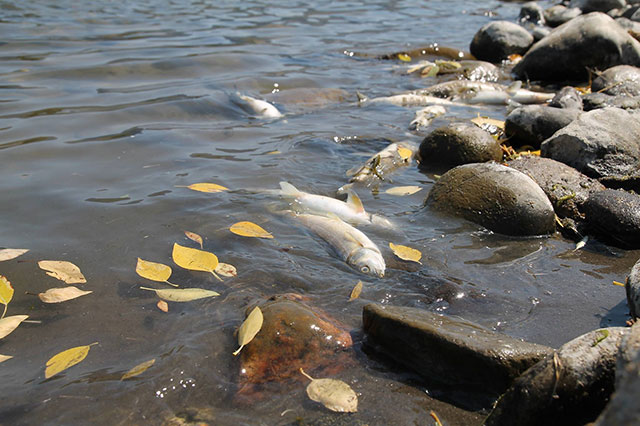
Early in the morning on August 19, 2016, Chad Jacobson, a 36-year-old Montanan, lifelong fisherman and soon-to-be father received a text message from a friend who is one of Montana’s many fly-fishing guides.
“Can you believe they shut down the Yellowstone?” said the text.
Jacobson grew up in a family of fishermen and makes it a priority to get out on the rivers as often as possible throughout the year. He was stunned.
“I mean, you see this kind of stuff happening in rivers around here, it’s something you can be almost sure will happen: low water and high temperatures leading to river closures and dead fish. But I don’t think that anyone was prepared for it to happen on the longest undammed river in the United States. It was a shock,” Jacobson told Truthout.
Reports of dead fish floating and collecting on the banks of the iconic Yellowstone River began coming into Montana Fish, Wildlife and Parks (FWP) in early August. The Yellowstone flows for 692 miles from Absaroka mountain range in Wyoming, through Yellowstone National Park, into the prairies of eastern Montana and finally, the Missouri River.
Alarmed, on August 12, 2016, state officials began surveying the river and found thousands of dead mountain whitefish, a native fish and known indicator species for river health. Indicator species signal a change in the biological condition of a particular ecosystem and are used as a way to diagnose the health of an ecosystem.
FWP officials took tissue samples from the dead fish to the US Fish and Wildlife Service Fish Health Center in nearby Bozeman, Montana. The whitefish were found to have died from Proliferative Kidney Disease (PKD), which is caused by a microscopic parasite known to occur in Canada, the United States and Europe. PKD kills fish by causing extreme inflammation in their kidneys and spleen. In the past 20 years, smaller and isolated outbreaks of the disease have occurred in two locations in Montana in addition to Washington, Oregon and Idaho. The parasite can affect all members of the salmonid family, including trout, salmon, char and grayling.
State officials were surprised at the scope and magnitude of the kill. Andrea Jones, spokesperson for FWP, at a press conference announcing the closure stated, “This kill is unprecedented in magnitude. We haven’t seen something like this in Montana.”
Seven years before this outbreak and far away from the banks of the Yellowstone, across the Atlantic Ocean, three European scientists published their research regarding PKD and the environmental conditions that give rise to outbreaks in the International Journal for Parasitology.
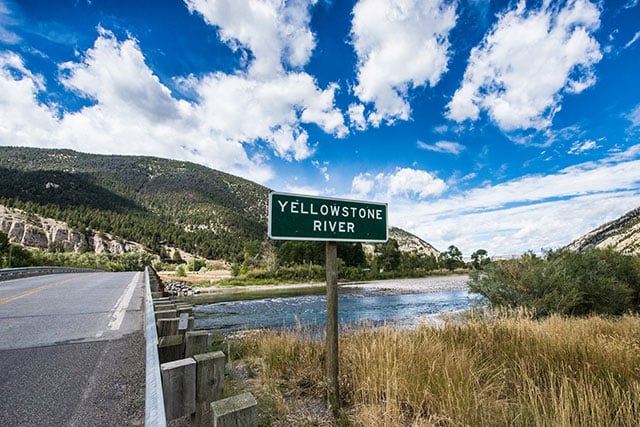 The Yellowstone River flows 692 miles from the Absaroka mountain range of northwestern Wyoming, through Montana and finally drains into the Missouri River in western North Dakota. (Photo: Alexis Bonogofsky)
The Yellowstone River flows 692 miles from the Absaroka mountain range of northwestern Wyoming, through Montana and finally drains into the Missouri River in western North Dakota. (Photo: Alexis Bonogofsky)
Dr. Beth Okamura specializes in Bryozoa, the organism that spreads the parasite. Okamura told Truthout that based on her research, PKD under normal, healthy river conditions is not problematic. She went on to remark: “When the environment changes, warmer temperatures and increased nutrient load, it causes unusual levels of parasite proliferation. Fish are also stressed as temperature increases. This, of course, fits with the outbreak in the Yellowstone River since lower water levels are presumably linked with higher temperatures and higher nutrient levels.”
Those higher water temperatures, increased nutrient loads and low water flows were the conditions that allowed the parasite to flourish in the Yellowstone.
After FWP discovered the cause of the fish kill, officials closed 25 percent of the Yellowstone River to all recreational use in order to prevent the spread of the parasite that could be transferred to other water systems from boots, waders and boats. The closure extended to hundreds of miles of the river’s tributaries. At the time, the US Geological Survey gauge in Livingston, Montana, the most impacted community, showed that the Yellowstone River was running at 1,930 cubic feet per second (CFS) — only 300 CFS above its all-time low.
Preventing the spread of the parasite to other rivers and streams will be difficult, according to Dr. Okamura, because the parasite can also spread to other water bodies without the help of human boats and waders.
“A growing body of work on the ecology of freshwater bryozoans, originating from early studies of my group, demonstrates that waterfowl can be important vectors of bryozoans,” she told Truthout. “It will be very difficult to contain this potential route of disease spread.”
In other words, ducks, geese and other birds that spend time in the water are also capable of spreading the parasite as they migrate between different water bodies.
On September 9, 2016, biologists from the Idaho Department of Fish and Game confirmed reports of thousands of dead whitefish on the South Fork of the Snake River in southeastern Idaho, likely due to PKD.
PKD is here to stay.
The New Normal
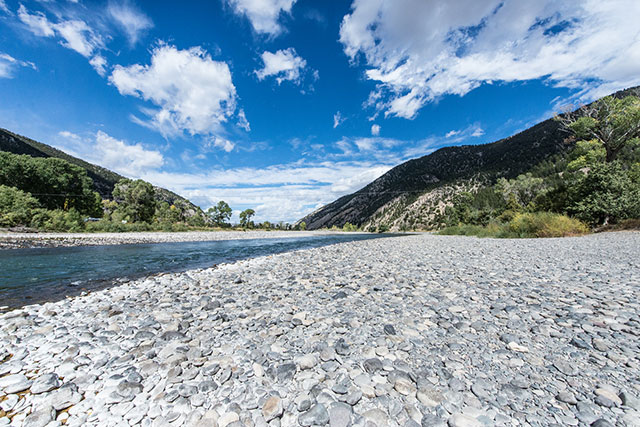 The Yellowstone River during high temperatures and low flow in August 2016 during the fish kill. (Photo: Alexis Bonogofsky)
The Yellowstone River during high temperatures and low flow in August 2016 during the fish kill. (Photo: Alexis Bonogofsky)
The scope of the fish kill and the conditions that surround it has climate change activists and river conservationists shaking their heads.
Guy Alsentzer, founder and executive director of the Upper Missouri Waterkeeper, an organization that focuses on protecting and restoring rivers in the Upper Missouri watershed, is frustrated with the current dialogue around rivers and climate change. He called the fish kill a minor but consequential ecological tipping point.
“People keep referring to ‘abnormal’ conditions and ‘extreme’ events,” Alsentzer said. “Those abnormal conditions and extreme events are not a temporary situation and they are no longer abnormal. The years of high snowpack, strong and stable run-off and resilient rivers are now the abnormal years. The future is here, this is happening to all of us, this is the new normal.”
To many, the fish kill is a symptom of an ecosystem in crisis. Montana, similar to the rest of the western United States, is already experiencing serious impacts from climate change. The state is hotter and drier; snowpack is decreasing; wildfires are becoming more severe and begin sooner; spring run-off from the mountains happens earlier every year; and there is less water in the rivers. Montana has already warmed 2 degrees Celsius and is expected to experience a temperature rise of 4 to 5 degrees Celsius by 2055. A 2 degree C rise is already causing dramatic changes to the West’s river systems.
“The conditions that are giving rise to these events are no longer temporary,” Alsentzer said. “We need to come around the table and talk about the facts. What are the new realities that cannot be debated? Our rivers are a shared public trust resource. We all need to be talking about how we can do better.”
The fish kill is not just an inconvenience for fishermen. The consequences of climate change are reverberating throughout Montana’s economy.
According to the Outdoor Industry Association, outdoor recreation in Montana generates $5.8 billion a year in consumer spending, $1.5 billion in wages and salaries, 64,000 direct Montana jobs, and $403 million in state and local tax revenue. They also found that 71 percent of Montana residents participate in outdoor recreation every year. Much of that activity occurs in and around Montana’s rivers.
In eight out of the last 12 years, high temperatures and low water flows have led to fishing closures and restrictions in Montana to prevent causing extra stress on fish already suffering from oxygen deprivation due to high temperatures. For example, three major trout species — brook, brown and rainbow — start to experience heat stress at around 68 degrees Fahrenheit with stress increasing rapidly as temperature rises. According to FWP, for more than a month from mid-July, daytime high Yellowstone River water temperatures near the most impacted part of the river hovered around 70 degrees Fahrenheit. Ideal temperatures for whitefish and trout are in the mid-50s.
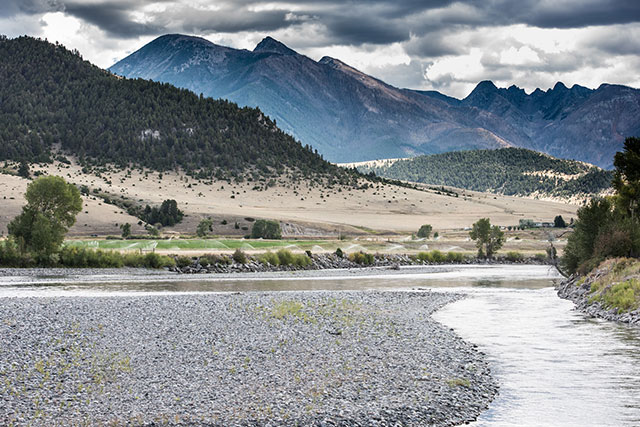 Sprinkler pivots irrigating farmland next the Yellowstone River in August 2016 during the river closure due to the fish kill. (Photo: Alexis Bonogofsky)
Sprinkler pivots irrigating farmland next the Yellowstone River in August 2016 during the river closure due to the fish kill. (Photo: Alexis Bonogofsky)
From 2001-06, 119 segments of rivers were either entirely closed to fishing or subject to access restrictions. In 2007 there were record-setting temperatures across the state. Forty streams and lakes were closed by the middle of August. The National Park Service closed 232 miles of streams in Yellowstone National Park to fishing that year. Then, in July of 2015, river restrictions for anglers were put into place, the earliest that river restrictions for anglers had ever occurred in western Montana.
A recent study detailing the climate impacts to Montana’s outdoor economy by Tom Powers, economist, research professor and professor emeritus at the University of Montana, found that Montanans are in for more frequent and longer restrictions on fishing to protect the fish already suffering from heat stress. Native fish species are likely to be lost and popular recreational fisheries will decline. Powers estimated the impact will be a one-third decline in angling days, and about 1,800 jobs and $49 million in labor earnings will be lost by 2050. And that’s just the impact related to recreation on Montana’s rivers.
Although the total economic impact of the recent fish kill has not been compiled yet, anecdotal evidence shows a huge impact on local businesses that rely on the river. Tina Marshall, ranch manager at 7 Point Ranch in Emigrant, which hosts events and offers lodging to travelers, told the Bozeman Daily Chronicle that the ranch lost $43,000 in cancellations after the river closure.
Rob Trotter, owner of the Yellowstone Raft Company in Gardiner, reported to High Country News that he and most of the other rafting companies had to close a month earlier than normal. He estimated that it cost rafting companies about $100,000 worth of lost business.
“It’s a big hit to us, not to mention to the restaurants, hotels, shuttle services and gas stations in Gardiner,” Trotter told High Country News.
The governor of Montana declared a state of emergency, which freed up $15.4 million of taxpayer money to go towards unemployment insurance, retraining programs and planning grants for workers and businesses affected by the river’s closure.
The outdoor industry isn’t the only one impacted by low flows caused by climate change. Irrigated agriculture is the number one consumptive user of water in the state. A recent irrigation report by the Blackfoot Challenge, a landowner-based organization that works to implement voluntary conservation efforts on the Blackfoot River in western Montana, found that in the Blackfoot drainage the amount of water needed to grow hay has increased from about 16 inches in the 1980s to over 24 inches now. Under Montana water law there are no restrictions on irrigation during extremely low flows and high temperature events on the rivers.
Wade Fellin, a fly-fishing guide on the Big Hole River who also has family that ranches in the valley, knows the challenges all too well. The Big Hole River dried up completely in certain spots in 1988. Irrigators and fishermen came together and formed the Big Hole Watershed Committee. Fellin’s father was a founding member.
“When you’ve got a resource completely dependent on snowmelt, you have to look at a holistic view of how water is being used from bathtub[s] and showers to flood irrigation to when the sprinkler pivots are being run. We are all in this together. Cows need clean water and fishermen eat beef,” Fellin told Truthout.
This type of organization doesn’t exist yet on the Yellowstone River. And the Big Hole, even with voluntary conservation measures by irrigators and fishermen that help maintain flows during drought years, still has large portions closed to recreation and fishing almost every year.
A recent report by the Montana Farmer’s Union predicts that the economic losses to the state just in agriculture because of climate change will be 25,000 jobs and $736 million in labor earnings by mid-century.
The Challenges Ahead: Water and Climate Change
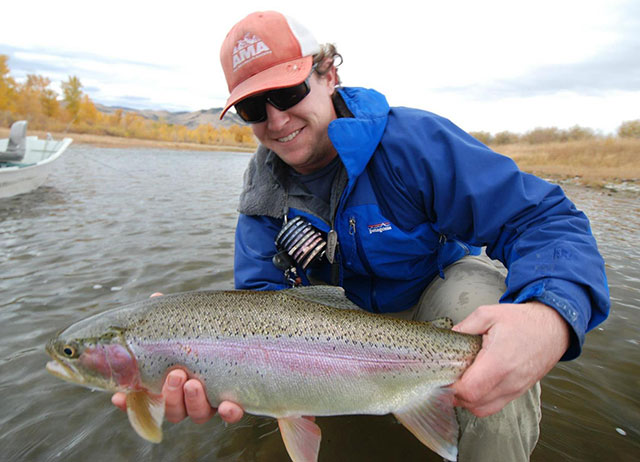 Chad Jacobson fishing on the Jefferson River in Montana. (Photo: Chad Jacobson)
Chad Jacobson fishing on the Jefferson River in Montana. (Photo: Chad Jacobson)
The fish kill on the Yellowstone put a sharp edge on Alsentzer’s view that Montana’s river management is not up to the challenges and the pressure put on the resource due to climate change. He says not many people want to talk about it.
“The barriers are enormous,” Alsentzer says. “There are a lot of people that need to come together from different perspectives and honestly discuss how our Montana traditions, agriculture and anglers no longer fit our reality. We have to look at our regulatory system and need to revise and rebalance it. We don’t have a ripe social climate to undertake a probing review of our water resources. Agriculture is important to the state and always will be but no one gets a free pass. We all need to do our fair share.”
In an ironic twist, on August 23, 2016, three days before the river was closed, residents of Colstrip, Montana, 240 miles east of the fish kill, were asked by Colstrip Mayor John Williams to limit their water use so that one of the largest coal-fired power plants in the western US could continue to operate.
Williams stated that low water levels in Yellowstone River and high temperatures were causing problems with the plant’s water-intake system. The town of Colstrip, population 2,314, and the coal-fired power plant draw 140,000 acre-feet, or 45.5 billion gallons of water out of the Yellowstone every year. Meanwhile, the coal power plant in Colstrip releases 17.5 million tons of greenhouse gases into the atmosphere annually, making it the nation’s third-largest emitter of climate pollution.
Todd Tanner, a Montana angler, former fly-fishing guide and president and founder of Conservation Hawks, a group formed to educate hunters and anglers about climate change, believes we need to tackle the root causes of the water problems.
“It’s easy to blame the problem on PKD, and to treat the Yellowstone fish kill as an isolated event. But it’s not an isolated event,” Tanner told Truthout. “If we really want to protect rivers like the Yellowstone, we need to kick our addiction to fossil fuels and stop raising the planet’s thermostat. This is a huge problem that requires a serious political solution. Wishful thinking and band-aids aren’t going to cut it. Citizens need to wake up and demand that Congress take climate change seriously.”
When asked what her message for water managers and policy makers in Montana was, Dr. Okamura said, “Ultimately the best way to manage the disease is to promote more normal water conditions — the cool, well-oxygenated and relatively oligotrophic (nutrient poor) waters that we associate with salmonids.”
In other words, rivers need clean water.
For his part, Jacobson is ready to fight for the rivers that he loves.
“I’ve started to think of these things on a much different level because I just found out that I’m going to be a father,” he said. “All of a sudden, it isn’t just my dirtbag self that I need to take care of these rivers for. But hey, the time to be fearful is long past. And I’ve learned that human emotions boil down to two for me, at this point. One is fear, and one is love, and I firmly believe that being fearful… has caused the stagnation of conversation resulting in not a whole lot being done. And love of the fish and love of the cold clean water and the places that it comes out of is really the only option for me.”
Our most important fundraising appeal of the year
December is the most critical time of year for Truthout, because our nonprofit news is funded almost entirely by individual donations from readers like you. So before you navigate away, we ask that you take just a second to support Truthout with a tax-deductible donation.
This year is a little different. We are up against a far-reaching, wide-scale attack on press freedom coming from the Trump administration. 2025 was a year of frightening censorship, news industry corporate consolidation, and worsening financial conditions for progressive nonprofits across the board.
We can only resist Trump’s agenda by cultivating a strong base of support. The right-wing mediasphere is funded comfortably by billionaire owners and venture capitalist philanthropists. At Truthout, we have you.
We’ve set an ambitious target for our year-end campaign — a goal of $230,000 to keep up our fight against authoritarianism in 2026. Please take a meaningful action in this fight: make a one-time or monthly donation to Truthout before December 31. If you have the means, please dig deep.